Components of Filtration
- Filter medium: This is the material through which the mixture is passed. It may be a porous material, such as filter paper, or a physical barrier, such as a mesh screen.
- Filtrate: The liquid that passes through the filter medium and is collected below it.
- Residue: The solid particles that are retained by the filter medium and collected on top of it.
- Filtration apparatus: This includes a funnel, filter paper, and a container to collect the filtrate.
Steps in Filtration
- Place the filter medium (e.g., filter paper) in a funnel, and set the funnel in a container to collect the filtrate.
- Pour the mixture to be filtered into the filter paper. The liquid will pass through the filter paper, leaving the solid particles behind.
- Collect the filtrate in the container below the filter paper.
- Remove the residue from the filter paper and dry or further process it if needed.
Applications of Filtration
Filtration is widely used in various fields, including:
Study Guide for Filtration
When studying filtration, it's essential to understand the principles, applications, and techniques involved. Here are some key points to focus on:
- Understand the purpose of filtration and when it is used in various industries.
- Learn the different types of filter media and their properties.
- Master the steps involved in setting up a filtration apparatus and carrying out the filtration process.
- Be familiar with the methods for improving the efficiency of filtration, such as using vacuum filtration.
- Explore the significance of filtration in everyday life and industrial processes.
[Filtration] Related Worksheets and Study Guides:
.◂Chemistry Worksheets and Study Guides High School. Properties and States of Matter
Worksheet/Answer key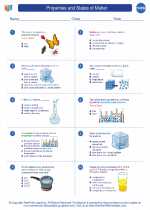 Properties and States of Matter
Properties and States of Matter  Worksheet/Answer key
Worksheet/Answer key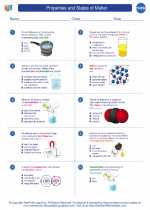 Properties and States of Matter
Properties and States of Matter  Worksheet/Answer key
Worksheet/Answer key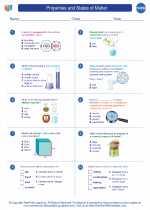 Properties and States of Matter
Properties and States of Matter  Worksheet/Answer key
Worksheet/Answer key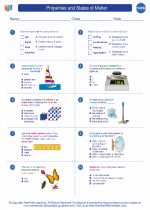 Properties and States of Matter
Properties and States of Matter  Vocabulary/Answer key
Vocabulary/Answer key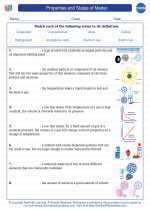 Properties and States of Matter
Properties and States of Matter  Vocabulary/Answer key
Vocabulary/Answer key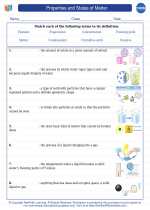 Properties and States of Matter
Properties and States of Matter  Vocabulary/Answer key
Vocabulary/Answer key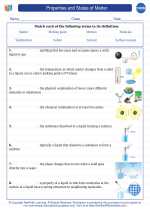 Properties and States of Matter
Properties and States of Matter 

 Worksheet/Answer key
Worksheet/Answer key
 Worksheet/Answer key
Worksheet/Answer key
 Worksheet/Answer key
Worksheet/Answer key
 Vocabulary/Answer key
Vocabulary/Answer key
 Vocabulary/Answer key
Vocabulary/Answer key
 Vocabulary/Answer key
Vocabulary/Answer key

The resources above cover the following skills:
Skills And Processes: The student will demonstrate ways of thinking and acting inherent in the practice of science. The student will use the language and instruments of science to collect, organize, interpret, calculate, and communicate information.
The student will explain why curiosity, honesty, openness, and skepticism are highly regarded in science.
The student will modify or affirm scientific ideas according to accumulated evidence.
The student will pose scientific questions and suggest investigative approaches to provide answers to questions.
The student will test a working hypothesis. (NTB)
The student will use relationships discovered in the lab to explain phenomena observed outside the laboratory.
The student will demonstrate that data analysis is a vital aspect of the process of scientific inquiry and communication.
The student will organize data appropriately using techniques such as tables, graphs, and webs (for graphs: axes labeled with appropriate quantities, appropriate units on axes, axes labeled with appropriate intervals, independent and dependent variables on correct axes, appropriate title).
The student will analyze data to make predictions, decisions, or draw conclusions.
The student will check graphs to determine that they do not misrepresent results.
The student will use analyzed data to confirm, modify, or reject a hypothesis.
The student will use appropriate methods for communicating in writing and orally the processes and results of scientific investigation.
The student will use computers and/or graphing calculators to produce the visual materials (tables, graphs, and spreadsheets) that will be used for communicating results. (NTB)
The student will use tables, graphs, and displays to support arguments and claims in both written and oral communication.
The student will communicate conclusions derived through a synthesis of ideas.
Concepts Of Chemistry: The student will demonstrate the ability to use scientific skills and processes (Core Learning Goal 1) to explain composition and interactions of matter in the world in which we live.
The student will explain that atoms have structure and this structure serves as the basis for the properties of elements and the bonds that they form.
The student will analyze the structure of the atom and describe the characteristics of the particles found there.
The student will explain how the properties of compounds are related to the arrangement and type of atoms they contain.
The student will explain how the properties of a molecule are determined by the atoms it contains and their arrangement.
The student will describe the properties of solutions and explain how they form.
The student will apply the basic concepts of thermodynamics (thermochemistry) to phases of matter and phase and chemical changes.
The student will explain that thermal energy in a material consists of the ordered and disordered motions of its colliding particles.
The student will describe observed changes in pressure, volume, or temperature of a sample in terms of macroscopic changes and the behavior of particles.
The student will explain why the interactions among particles involve a change in the energy system.
The student will explain that matter undergoes transformations, resulting in products that are different from the reactants.
The student will describe the general types of chemical reactions.